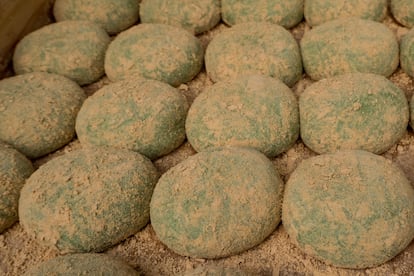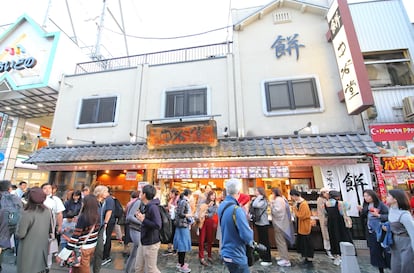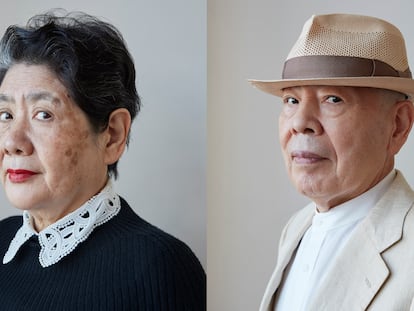A journey to the origins of Japanese ‘mochi’ and its ancient ritual
The most authentic version of these rice cakes is made in the city of Nara with old-fashioned tools. Hundreds of tourists visit the workshop daily to see how it is made

The original mochi, probably the most authentic one in the world, is yomogimochi. This Japanese rice cake is made at Nakatanidou, an establishment in Nara where ancient techniques and tools are used and where crowds of visitors show up every day, eager to witness the spectacle of their creation. Everyone is in awe at the expertise of the master, Mitsuo Nakatani, the Lord of the Mochis, who is recognized throughout Japan as an emblematic figure. This establishment’s prestige is due to the dramatic process of making yomogimochi, the house specialty. At Nakatanidou, workers painstakingly follow the directions of an original mochitsuki (mochi-making ceremony) to produce hundreds or even thousands of units, freshly made, after grinding the rice paste.
This round-shaped cake is made from mochigome (glutinous rice grain) flour, mixed with water, sugar and cornstarch. Once cooked, it is placed in a large wooden mortar where it is beaten with a huge mallet, just as it was done 200 years ago. You have to be very skilled to follow such a well-paced rhythm and adjust to the movements required by the choreography. The quick, sharp blows make the mochi soft and elastic, but with a firm texture.
Today you can try mochis anywhere in the world. There are industrial ones and artisanal ones, matcha tea mochis and cheesecake mochis. The smooth consistency of this ancestral sweet has become essential in many diets. Its origins go back to the Uzura Mochi that dates to the late Muromachi era (1336-1573). According to Japanese religion and mythology, the first mochitsuki ceremony took place when the gods descended to Earth to teach humans how to grow rice. In Genji Monogatari, the oldest text of Japanese literature, written by Murasaki Shikibu in the 11th century and compared by critics to Homer, mochi first appeared as an offering to the gods. In the Heian period (from the 8th to the 12th century) it was a food idolized by royalty and nobility. In the 13th and 14th centuries, its consumption spread to the tea ceremony.
Yomogi is a Japanese wild plant, also known as mugwort, highly renowned in Japan for the therapeutic virtues it provides in tea. It gives the mochi its natural green color and refreshing flavor. And to make a yomogimochi, it is filled with anko (red bean paste) while kinako (roasted soy flour with a peanut-like aroma) is added to cover it.
As the huge green mound of glutinous rice is thrown into the large mortar, excitement among the audience builds and mobile phones light up. It is important to find a first-row spot as early as possible to see the workers in action. They are so experienced that they pound the mochi relentlessly and without pause, punctuating each blow with a shout. After each one, one wonders what they are exclaiming or what they are thinking about. It is a perfectly synchronized ritual. There are no errors. There is only applause.
Master Nakatani comes from a town much further north, Kamitiyama, in the mountains of the Yoshino district, where it is colder than in Nara and where mochitsuki takes place in winter. It is from there that he brought this ancient method of making mochi.

Nara is a small city in the Kansai region near Kyoto, famous for having been the historical capital of Japan, for its Todai-ji temple, which houses a great 15-meter bronze Buddha, and, above all, for its hundreds of deer. These animals move freely about the park and the city streets (in fact, they even know how to handle the pedestrian crossings). They shamelessly go up to people, even nodding their heads as they pass, confident in the knowledge that they hold a sacred place in mythology and are considered “national treasures.” How beautiful the deer are, how endearing, how docile...and even more so when the visitor has food in their hands. In view of their voracity, it is quite normal to run out of offered food, so it is best to buy them what they like the most, rice crackers. Deer in Nara are nuts about rice. But they are not the only gourmets fascinated by derivatives of this cereal. And there is only one creature in Nara who can be happier than the deer: the human being who has tasted Nakatanidou’s mochi.

This establishment won the national mochitsuki championship consecutively in 2005 and 2006; since then, they have become a place of pilgrimage for fans of this ceremony. The speed of the blows is inversely proportional to the speed with which the mochis fly, by the dozen, out of the sales clerks’ hands. Nakatanidou is open from 10 a.m. to 7 p.m. Each mochi costs 130 yen ($0.91 or €0.85) and only cash is accepted. It is very rare for anyone to buy single units, so there are boxes to go. It’s hard to find a more spiritual fast food from so far back in time. It is held in one hand and eaten faster than you can feed 10 rice crackers to a deer.
Sign up for our weekly newsletter to get more English-language news coverage from EL PAÍS USA Edition
Tu suscripción se está usando en otro dispositivo
¿Quieres añadir otro usuario a tu suscripción?
Si continúas leyendo en este dispositivo, no se podrá leer en el otro.
FlechaTu suscripción se está usando en otro dispositivo y solo puedes acceder a EL PAÍS desde un dispositivo a la vez.
Si quieres compartir tu cuenta, cambia tu suscripción a la modalidad Premium, así podrás añadir otro usuario. Cada uno accederá con su propia cuenta de email, lo que os permitirá personalizar vuestra experiencia en EL PAÍS.
¿Tienes una suscripción de empresa? Accede aquí para contratar más cuentas.
En el caso de no saber quién está usando tu cuenta, te recomendamos cambiar tu contraseña aquí.
Si decides continuar compartiendo tu cuenta, este mensaje se mostrará en tu dispositivo y en el de la otra persona que está usando tu cuenta de forma indefinida, afectando a tu experiencia de lectura. Puedes consultar aquí los términos y condiciones de la suscripción digital.
More information
Últimas noticias
Most viewed
- Oona Chaplin: ‘I told James Cameron that I was living in a treehouse and starting a permaculture project with a friend’
- Sinaloa Cartel war is taking its toll on Los Chapitos
- Reinhard Genzel, Nobel laureate in physics: ‘One-minute videos will never give you the truth’
- Why the price of coffee has skyrocketed: from Brazilian plantations to specialty coffee houses
- Silver prices are going crazy: This is what’s fueling the rally











































